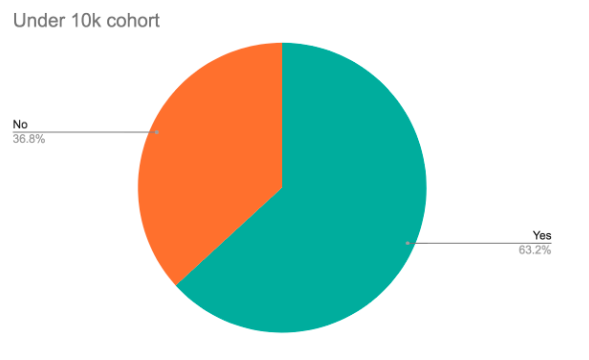In the online course space, we often hear debate around if and when you should give away free content. While some creators see giving away free content as an essential part of their strategy, others say that giving anything away for free devalues their time and attracts low-quality leads.
The debate is a valid one. On the one hand, you need to give your audience a taste of the value you can offer before you can expect them to buy. On the other, will those who take you up on your free content really be ready to pull out their credit cards when the time comes to buy, or are they just in it for the freebies?
We love a good debate here at Teachable, but not as much as we love data. That’s why last quarter, we started conducting research to learn what course creators actually do—and what works—during a course launch. During our research, we heard from about 200 course creators who have made between one thousand and twenty thousand dollars within the last twelve months. They told us everything about their course launches. From what their courses were about, to how long they took to create, to how they used free content throughout their launch. We’re here to lend some data to the debate on free content.
Start your launch with an education phase
In our research, we dug deep into how our creators were using and benefiting from offering free content during launches. To gauge that, we asked our participants if they included an education phase within their launches.
An education phase refers to a strategic section of a course launch during which you don’t explicitly sell to your audience. Instead, you focus on giving them value and teaching them any prerequisite information they would need in order to feel “qualified” to purchase your product.
“An education phase refers to a strategic section of a course launch during which you don’t explicitly sell to your audience.”
If a course launch campaign lasts between two weeks and a month, we’d typically see education phases that cover between one and three weeks of the launch calendar. During an education phase, creators send emails to their list sharing free value in a variety of formats such as blog posts, infographics, PDFs, and videos.
Angela Fehr, whose school on Teachable is all about teaching beginners to paint watercolor with confidence, is a wonderful example of what an education phase can do. She uses an email series she calls the ‘Fearless Artist’ series that’s all about overcoming the emotional hurdles of becoming an artist. Here’s a short excerpt from email four in that series, with the subject line “Fearlessly Breaking the Rules,” to give you a sense of what they’re all about:

Being ‘fearless’
In addition to this email on challenging the notion that there are “rules” in art, Angela’s ‘Fearless Artist’ series covers topics like becoming your own favorite artist, how to be okay with being a beginner, and giving yourself permission to feel like an artist. It’s important to note that these are not sales emails. For Angela, they’re all about giving back and helping her audience feel ready to dive into learning a new skill.
Angela says that when she’s writing these emails, “I ask myself: how do I want people to feel after reading this email? Leaving them feeling encouraged, fed, or supported is critical.”
Angela’s tactics are proven to work and easy to replicate. Here are some of the reasons we recommend engaging with your audience before asking them to buy:
- It builds trust and shows your audience that you can provide value
- Top creators all do it! They often cite including this “warm-up” phase any time they run a launch
- It helps train your audience to expect and open your emails
- The numbers don’t lie! All our research supports this strategy
From our research, we can tell that in our research group the majority of members have been following this advice. When asked if they included an education phase in the specific launch they shared data about, 67% of creators responded that they had.

{{threesteps-component="/blog-shortcodes/blog-popup"}}
Does providing free content help you make more money?
Once we found out that our respondents were very likely to have given away free content in an education phase during their launch, we were interested. We wanted to learn if there was any correlation between this practice and how much revenue a launch generated. When we broke down our research into earning cohorts, we found that those who had made between $10-$20k during their launch were even more likely to have included an education phase in their launches versus those who had made between $1K and $10K.
Of those who earned $10-$20k during their launch, over 80% reported having used an educational phase within their launch in comparison to only about 63% of those who earned less than $10k in their launch.


There were certainly more factors at work in these members’ successful launches than just including an eductation phase. That said, based on the data we’ve presented and our own past experiences with course launches, if we were launching a course, we’d definitely include an education phase. And we think you should, too. (By the way—if you’ve launched a course on Teachable, we’d love to hear from you about your launch to help make our data more complete! You can participate in our research here).
To help you plan your education phase to make it as impactful as it can be, we’ve put together a list of five tips you can use alone or combine to make your education phase, and your course launch, a success.
How to run a successful course education phase
1. Get your audience ready to take your course with a ‘toolkit’
We know that course creators often experience “imposter syndrome” when they first start out. They’re worried they’re not enough of an expert in their niche to teach it. Believe it or not, students feel that, too. Some of your potential students may not buy, even though they’re interested in your course. It’s hard for them to imagine feeling “ready” to start learning a new skill. A great way to close that “readiness gap” for your students is to provide a free toolkit PDF in one of the emails in your education phase.
Let’s take a course on woodworking as an example. Potential students might be extremely interested in learning to woodwork, but they might be concerned they’re not ready to start because they don’t have the necessary supplies. Creating a PDF called “The only five supplies you need to get started as a woodworker” could help these students feel less intimidated when you launch your woodworking course the following week, since they’ll already feel confident they have the prerequisite items.
Pro tip: you can use tools like Canva to make your free content look beautiful and professional.
P.S. A toolkit doesn’t need to be for physical stuff. You can also use this strategy to help show your audience that they have the prerequisite skills to start your course.
2. Give your audience a taste of what’s in your course
You may not want to give your audience your signature strategies for free. However, giving them a taste of what you’re like as an instructor and the format they can expect from your course can help warm them up. It makes them feel excited when you finally let them know you have a course for sale.
If every section of your course will include a video, a downloadable PDF, and a quiz, consider sharing some content within that format with your email list for free prior to announcing your course. That way, your audience will build some comfort with your teaching style. Plus, when your course comes out, they’ll have an easier time understanding what to expect from you.
Remember: Any information you share during this phase should stand alone. Therefore, don’t just pick out a section of your course if it doesn’t make sense outside the sequence. Either create supplementary content or choose a section of your course that speaks well for itself.
3. Nerd out about your topic with some fun facts or history
More likely than not, your course is all about teaching people how to do something. For some niches, you might want to take your education phase as an opportunity to share some of the less actionable, but still fascinating things. Share what made you passionate about your topic in the first place.
Imagine a course in which you’re teaching cooking techniques for a specific type of food. You might want to focus mostly on recipes throughout your actual course. However, in your education phase, sharing insights about the history of the foods or specific cultural events they’re usually served at will help get your audience excited about learning to cook them.
4. Make yourself available for a Q&A
Your education phase is also a great time to get some face time with your audience. Providing free value during this phase is all about building trust, demonstrating your value, and showing your expertise. All things you can accomplish through a Q&A video.
Schedule some time where your audience can hop on a video with you and ask you questions live. If you’re able to give them value during your Q&A, when you launch your course, they’ll be all the more trusting that your course will be able to do the same.
5. Provide a miniature transformation
Your course itself should provide a clear transformation. When your students buy, they should understand how your course will help them not just learn a new skill, but actually be different after they take your course than they were before. Maybe your course allows them to be more confident in your subject area than they were before. Perhaps it allows them to save money. Maybe it helps them move into a new career. Whatever the transformation, the most valuable courses provide a clear ‘before and after’ for their students.
A great way to prove your value before your audience makes an investment in your course is to provide a miniature transformation within your free content, too. For example, maybe you’ll share a tip to help your audience build a small new habit that will set them up for success with your course. Maybe you’ll help them reach the first milestone in your course before they even buy. Whatever it is, showing your audience that you can help them reach an outcome is a powerful way to demonstrate your value before you launch your product.
Let us know if you decide to use free content as a part of your launch
We’d love to hear from you if you utilize free content in your marketing strategy or launch! If you’ve launched recently, no matter the level of success you achieved, please tell us how it went via our survey.
Join more than 150,000 creators who use Teachable to make a real impact and earn a real income.


